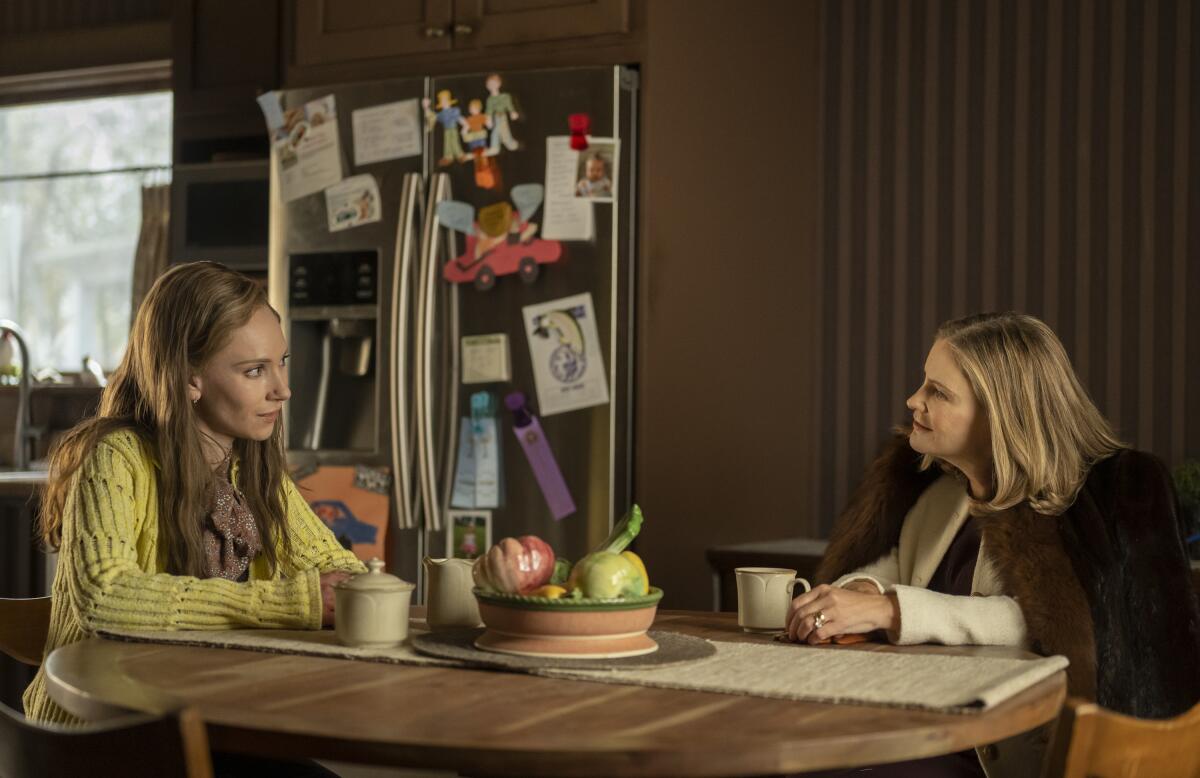‘Fargo’ Season 5 review: Returning to its roots, with more strong women
The new season of “Fargo,” Noah Hawley’s fifth variation on a theme by the Coen brothers, arrives Tuesday on FX. (It streams Wednesday on Hulu.)
The anthological series, which I never quite expect to return and am surprisingly excited when it does — it’s music I like, but it takes its time between seasons and fades from memory — takes certain geographical, thematic and tonal elements from the Coens’ 1996 film. It will be bloody; like a Dickens novel, it will bring together various strata of society. There is usually an honest officer, or officers, of the law; someone in over their head; and a hard-to-stop, possibly crazy hired killer. In most seasons there is snow. They share something of the architecture of the Western, which the current season makes more than usually explicit with a complement of cowboy hats, horses, cattle and prairie views. And every year has been a masterpiece of inventive casting.
The fourth season, which aired in 2020 and starred Chris Rock and Jason Schwartzman, was something of a departure, a big-canvas story set in the early 1950s in which Black and Sardinian mobs vied for control of Kansas, Mo., farther from Minnesota and North Dakota, the series’ spiritual and often actual center. It was an even bloodier season than usual, leaving its main and many minor characters dead; yet it still found a way, in “Fargo” fashion, to end on an upbeat note.
The new season is something of a return to its roots. We are back in Minnesota (and North Dakota), in cold weather, and the nearly present day, at a school fall festival planning committee meeting where Dorothy Lyon (Juno Temple) is attempting to keep her head when all about her, ordinary citizens are whomping the stuffing out of one another. (“I’ve Seen All Good People” by Yes blasts on the soundtrack, very effectively.) As she tries to flee the scene with her daughter, Scotty (Sienna King), she winds up tasing a math teacher and a couple of policeman, which lands her in jail, introduces us to Deputy Indira Olmstead (Richa Moorjani), the latest of “Fargo’s” dogged female cops, and sets off the alarm that will bring trouble calling.

Dot (Juno Temple), left, with her imposing mother-in-law Lorraine (Jennifer Jason Leigh).
(Michelle Faye/FX)
Dorothy is married to Wayne (David Rysdahl), a likable lug who has a car dealership, a trust fund he doesn’t touch and an imposing mother, Lorraine (Jennifer Jason Leigh), who runs “a Nasdaq-listed multibillion corporation” and has “six governors on speed dial and my own personal liaison at the Federal Trade Commission.” Her company, Redemption Services — the religious overtone seems intentional, though it may be only an overtone — buys consumer debt. (And debt, of different sorts, is a recurring theme through the series, including a yet to be explained, if ever, brief flashback to medieval Wales.)
Lorraine does not much care for Dorothy, whom she dismisses as lower class and possibly after her money. But that there is more to her than chirpy housewifery soon becomes apparent, as Dorothy puts up a defense against a pair of masked kidnappers — Sam Spruell as Ole Munch is this season’s designated oddball killer. Before long, it leads to a beautifully staged, very suspenseful fight scene — the sort of scene that would form the climax of most movies — set in a lonely gas station convenience store that brings Lamorne Morris into the story as North Dakota Deputy Witt Farr.
Incidentally or perhaps inspirationally, Morris’ character on “New Girl,” Winston Bishop, finished that series in a police uniform; similarly the character played here by Jon Hamm, Roy Tillman, the sheriff of a very rural North Dakota county, who quotes Bible verse on the way to doing whatever he wants to, seems related to the cult leader he played in “The Unbreakable Kimmy Schmidt.” (Joe Keery plays his hapless son and deputy, Gator.) We glimpse him only briefly in the opening episode, in a single shot, sitting sternly at the head of a dinner table, but it tells us that whatever is mysterious about Dorothy has something to do with him.
The series always has at least a little to say about Who We Are, or Who We Were, or How Who We Were still informs Who We Are. The final episode of last season, which looked at racism through a framework of organized crime, was titled “Storia Americana”; Ronald Reagan, played by Bruce Campbell, was an actual character in the second season, set in 1979. This year, the show is set in 2019 — the closest of any season to the time it’s being released in — and you would have to actually not watch the series to miss its points, about weak and toxic men, sexism, misogyny, religion as a tool of oppression, and far-right…
Read More: ‘Fargo’ Season 5 review: Returning to its roots, with more strong women

